How Restaurants Are Profit Maximizing
What is the Profit Maximization Rule?

The primary goal for restaurant owners is meeting market demand and maximizing quantity in cost profit. When maximizing profits, the restaurant owner and management staff work together to generate profit without undercutting everything else. To get a profit maximizing level to where it needs to be, a cost producing formula must be used.
Using The Right Formula
The formula used to determine revenue marginal cost is known as the profit maximization rule. Profit maximization is grounded in economics. The rule is represented as MC (marginal costs) = MR (marginal revenue). In other words, profits are maximized when the marginal costs of creating a product are equal to marginal revenues.
This profit maximizing formula is a shifting equation complex in nature. The figure illustrates all factors in the marketplace to for maximizing price and maintaining accuracy, including-
- Balancing Expenses/Revenues- Developing a new product like a menu item can have a heavy output price attached to it. Manufacturing, packaging, and advertising are all things to consider as costs. These total costs are the factors that need to be lower or equal to the revenue that is expected from the product. If they're not, some adjusting should be made to maximize profit.
- Unexpected Costs- When budget is put together for new product creation, anticipating unforeseen costs is a challenge. For example, if the menu item doesn't do well with customers it generates a lower profit than initially planned. When this happens, adjustments to the profit maximization equation will need to be made like the price charge. Having a lower price on the menu or to change quantity of ingredients ordered will level output prices. The extent of demand for the product will be affected by the price that is set. This is known as "price elasticity" or "elasticity demand."
- Employee Costs- Labor is an higher price that can cause a significant impact to most restaurant businesses. This includes employee pay and maintaining safety standards in employee work spaces. To maximize profits in this area means settling for minimum quality by offering the lowest wage that qualified employees will accept. It can also mean having a smaller staff on hand to complete the daily tasks at a marginal cost.
Profit Maximizing Through Calculations
An 3-5% profit margin is average for most restaurants. However, the range can fall anywhere from 0-15% depending on the service provided and the unit output of quantity produced.
Market demand curve will affect the profit maximizing quantity. However, examples of an average profit margin by restaurant type highlights the perfect competition model of the restaurant industry. As follows-
- Fast-food restaurant 6 to 9%
- Full-service restaurant 3 to 5%
- Catering services 7 to 8%
- Food trucks 6 to 9%
How to Calculate Restaurant Profit Margin
There are two types of profit margin-
- Gross profit- The profit remaining after the cost of goods sold (COGS) has been deducted.
- Net profit- Profit remaining after all costs of running the restaurant are deducted from the gross revenue.
Increasing Profit Margins
With the profit margin percentage calculated it can be used to determine where the revenue or expenses should be adjusted.
If the demand for the product is equal to the quantity being supplied there will be no surplus or shortage. This type of price total is known as the equilibrium price.
Here are a few ideas to meet market demand and increase a profit margin-
Optimize the Menu
Menu items should have a market price point that is competitive in the marketplace. That doesn't necessarily mean more expensive, but rather a high selling option. Whichever food items generate the most sales should be mainstays while newer items can be tested for best value.
Embracing Technology
Technology is streamlining the restaurant industry by compartmentalizing many tasks into one. For example, a POS system can be used for more than accepting payments. It can also track employee performance, manage inventory, and generate insights for the business through data mining at a marginal cost.
Website Presence
An optimized online presence will generate response from customers searching for restaurants in their area. Even a basic website will be useful so long as it has contact information, directions to the location and a sample menu.
Online ordering and delivery
With a website in place, the next idea is to add online ordering and delivery options. This can be done without a website as well by having an app available for customers. Statistics show that 60% of consumers in the United States order online at least once a week. The market demand for online ordering capabilities can increase total revenue.
A strong restaurant profit margin is necessary to remain successful in the restaurant business. With a few tweaks and calculations the profit maximizing can be accomplished for continued success.
Last Words on Profit Maximizing

- The profit maximization rule is a formula that looks like this- represented as MC (marginal costs) = MR (marginal revenue).
- An average cost for restaurant profit margin can be from 0-15% with most falling in the range of 3-5%.
- Net profit percentage is determined by dividing the net profit by the total revenue and multiplying it by 100.
- Equilibrium price is when the quantity of goods meets the demand in an equal way.





